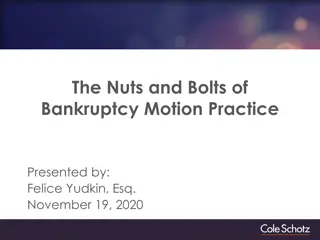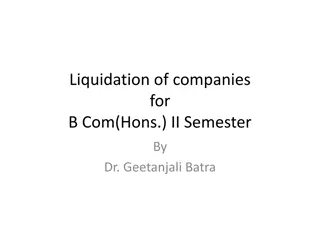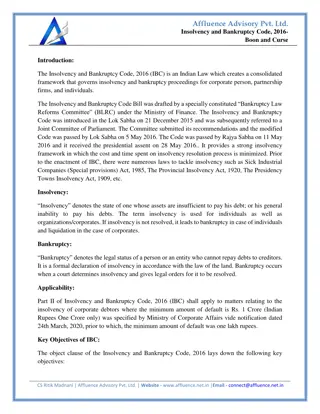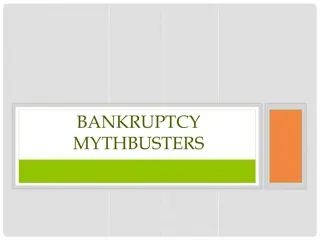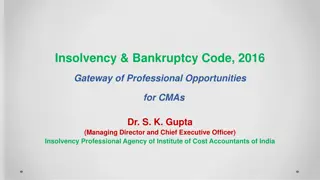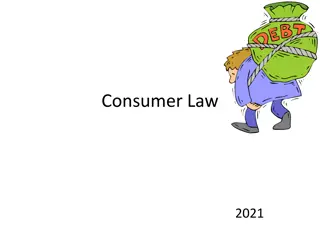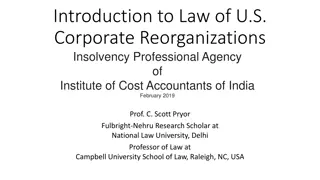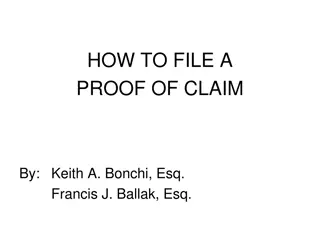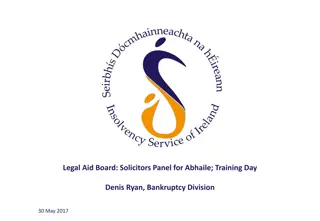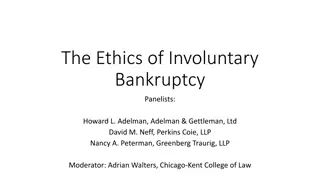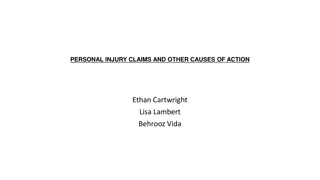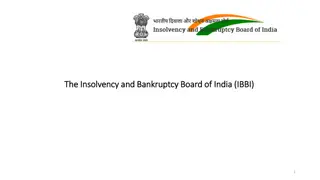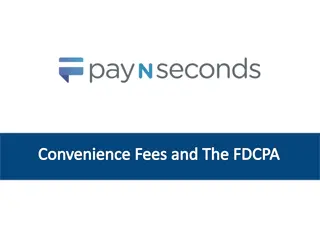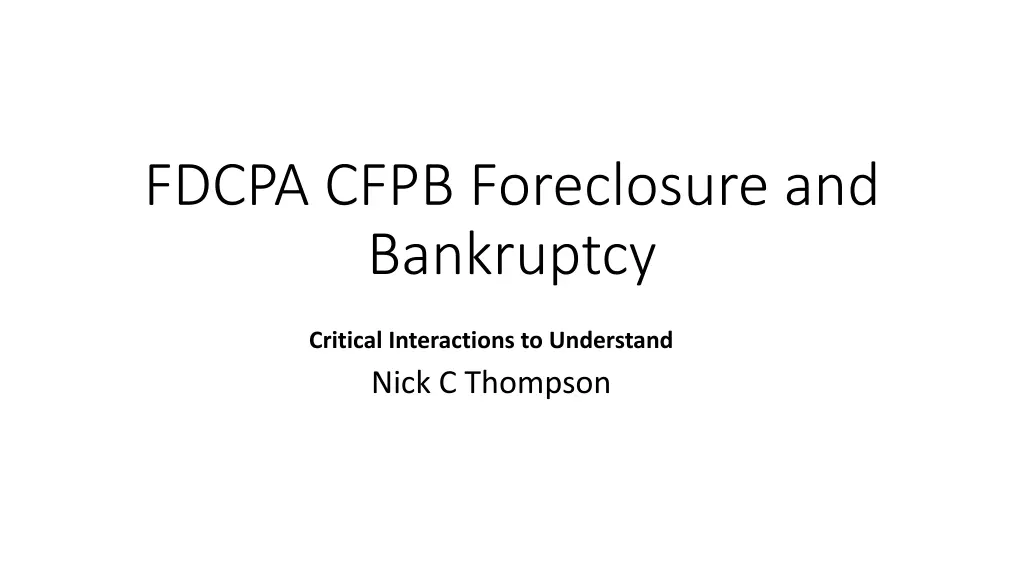
Understand Critical Interactions in FDCPA, CFPB, Foreclosure, and Bankruptcy
Learn about the essential interactions between FDCPA, CFPB, foreclosure defense, and bankruptcy to navigate legal processes effectively. Discover insights on saving homes, filing claims, and maximizing benefits from these laws.
Download Presentation

Please find below an Image/Link to download the presentation.
The content on the website is provided AS IS for your information and personal use only. It may not be sold, licensed, or shared on other websites without obtaining consent from the author. If you encounter any issues during the download, it is possible that the publisher has removed the file from their server.
You are allowed to download the files provided on this website for personal or commercial use, subject to the condition that they are used lawfully. All files are the property of their respective owners.
The content on the website is provided AS IS for your information and personal use only. It may not be sold, licensed, or shared on other websites without obtaining consent from the author.
E N D
Presentation Transcript
FDCPA CFPB Foreclosure and Bankruptcy Critical Interactions to Understand Nick C Thompson
Foreclosure Defense v Chapter 13 Defending a foreclosure may save a home if you obtain a workout agreement or modification. But less than 10% were approved and most homes in foreclosure were eventually abandoned from 2008 to 2013. Chapter 13 is a tool allowing the Debtor to take up to 60 months to cure. If the Debtor can catch up the payments in Bankruptcy court the Debtor is far more successful at keeping the home. If litigation grinds on in state court the Debtor falls further behind in the mortgage. The amount the Debtor has to repay in a Chapter 13 increases. If there is litigation in state court a Chapter 13 becomes less likely to cure the arrears. If the home is to be saved the Debtor normally has to file a Chapter 13 early.
A person may file an answer to a foreclosure and bring Regulation X, Regulation Z or FDCPA claims in state court or a federal court CFPB enforces, and drafts Regulation X, and Regulation Z. It is involved with FDCPA and UDAP actions. Bankruptcy court has judges who are more experienced with debt collection cases than state court judges. FDCPA cases often involve facts which are also violations of the stay which threaten the bankruptcy court itself. FDCPA uses a strict liability standard. If you prove a violation of any numerated section you have liability.
The Purpose of the FDCPA is to punish creditors for Unfair & Deceptive Practices Recognizing an FDCPA case can be difficult, but the same behaviors that enable FDCPA violations cause people to file bankruptcy. It helps to use a checklist of the numerated violations to discover offenses. In general Debt collectors must treat Debtors with truth, fairness, dignity, and respect. What collectors engage in is often abuse, shame, blame, fear, harassment, deception and unfair tactics. These may also be UDAP claims. Many of the violations in an FDCPA case arise in or under the bankruptcy. They are also often contempt of the bankruptcy court stay 11 USC 362 or discharge order 11 USC 524 which threaten the court and trustee s administration of the estate. It can add punitive damages. These cases should be brought as an adversary matter and not a motion for contempt to maximize damages and attorney fees. 11 USC 524 is a violation of the discharge injunction brought after the case.
Filing FDCPA cases can repay a debtor for a Filing FDCPA cases can repay a debtor for a bankruptcy and increase office profit bankruptcy and increase office profit Even a small technical violation with only statutory damages of 1,000 will help pay the client fees for a bankruptcy. Most violators breech multiple sections but the $1,000 in FDCPA damages is per case. Even prosecuting 1-2 small technical violations per month will mean an attorney fee recovery fund which may fund a law office operation. During times when filings are down this will insure an office stays in business.
Elements of the FDCPA case. Is this a consumer debt. Elements of an FDCPA case a FDCPA case is for a consumer debt. 1692 elements are 1692a (3) a person obligated on a debt. See 6th Circuit case a business is a person defined by Federal definitions. This business paid for a consumer debt and was allowed to file an FDCPA claim. 1692a (5) obligated for personal, family, or household purposes. Collected by 1692a (6) a debt Collector, collection agency, lawyer or forms writer. Many FDCPA cases are also contempt of the bankruptcy court stay or discharge which can add punitive damages. FDCPA add other claims ex: contempt of stay or discharge and show how it effects the estate to insure claims arise under the core jurisdiction of the court.
In bringing the case Analyze the client Is the client credible. If the client improves the facts don t bring the case and rely on the client for evidence. Keep it simple and relying on documents if the client is weak. If the case is based on written letters there may be little or no need for client testimony for evidence. Is the client reliable. Will the client show up for trial or depositions? If not, you may want to keep it a small case. If the conduct is serious you may want to bring the case regardless before the judge and the poor irrational client may be the result of the harassment. Or you may wish to settle by letter early in the case.
Analyze the case How does the client s case present itself? Does the client and the acts of the collector cry out for punishment of the creditor? FDCPA is a strict liability statute to punish specific conduct. Like worker s compensation no negligence or evil intent is required. Cases are intensely fact and story driven. Complaints should: explain what happened and then explain the harm to the 1) client 2) the administration of the court and 3) bankruptcy estate in the first paragraphs with bullet points Research and Show If this is a part of a pattern or practice you may obtain punitive damages. FDCPA is for actual damages and attorney fees you must include other causes for punitive damages.
Analyze the Evidence Interviewing the client is intensive fact gathering. An interview with real punitive damages case will take 3-4 hours with follow up fact and evidence gathering. A simple case such as sending a letter, fax, or filing a lawsuit letter after discharge will take 1-2 hours. Records are vital to the case. Letters and phone records establish the case. Former Employees are often fired and are impartial and credible witnesses who know the creditor. Attach other complaints to establish a pattern or practice by a creditor.
Bringing the case to the attention of the court Cases should be brought as an adversary matter and not a contempt motion to maximize the damages and attorney fees. Violation of the stay under 11 USC 362. Violation of the Discharge 11 USC 524 (a) (2). 524 has no enforcement provision for a private right of action but damages may be awarded. See also 105 (a) for equitable powers. Facts are accepted by a judge far more easily if there is either no dispute of the fact or interpretation of the fact and the judge comes to his/her own conclusion. FDCPA cases may be hard to identify but many acts are numerated in the code.
Bankruptcy Jurisdiction must be proper Bankruptcy Jurisdiction must be proper Jurisdiction 28 U.S.C. 1334(b). The jurisdictional statute thus offers three types of bankruptcy proceedings cognizable in bankruptcy court: relating to, arising in, and arising under. Arising in or under is the core jurisdiction for the bankruptcy court. If it effects the estate it is core. A case relating to but not effecting the estate will normally be dismissed for lack of jurisdiction. All circuits allow claims for abuse 1692 (d), Most will allow for 1692 (e) misrepresentation, and 1692 (f) unfair and deceptive 1692 (b) or (c) improper communication claims.
Contacting third parties Contacting third parties 1692 b(1) Failing to identify themselves or failing to state they are confirming or correcting location. 1692 b(2) Stating that the debtor owes any debt to any 3rdparty 1692 b(3) Contacting any party more than once, unless requested to do so. 1692 b (4) Using postcards or notes 1692 b(5) any language or any symbols on any envelope or communication indicating it is a debt collection business. 1692 b(6) Any communication with the debtor after notice the debtor is represented by an attorney. 1692 b
Prohibited Communication Practices Prohibited Communication Practices 1692 c 1692 c 1692 c(a)(1) Contacting the Debtor using unusual time or places before 8 am after 9 pm. 1692 c(a)(2) Contact after the collector knows the client is represented by an attorney. 1692 c(a)(3) Contact at a place of employment when it knows it is prohibited. 1692 c(b) Contact with anyone except consumer, credit bureau or his attorney concerning the debt 1692 C (c) After any written notice the consumer refuses to pay the debt or wants communication to cease
Harassing Harassing Communications Communications 1692 (d) 1692 (d) 1692 (d) Any conduct where the natural consequence of is to harass, oppress or abuse any person 1692 (d)(1) Communication used to threaten violence or other criminal means to harm 1692 (d) (2) Profane or abusive language 1692 (d) (3) Publication of a consumer who allegedly refuse to pay a debt 1692 (d) (4) Advertise a debt for sale 1692 (d) (5) Repeated telephone communications 1692 (d) (6) Place phone calls without disclosing their identity
False or Misleading Communication False or Misleading Communication 1692 (e) (over 16 acts) 1692 (e) (over 16 acts) 1692 (e) False, deceptive, misleading representation in connection with debt collection 1692 (e) (1) Representation of any affiliation with the US or a state including any badge, uniform or facsimile 1692 (e) (2) Character amount or the legal status of the debt 1692 (e) (3) Any individual is an attorney or the communication is from an attorney 1692 (e) (4) Nonpayment will result in an arrest or garnishment 1692 (e) (5) Threaten to take an action that cannot be legally taken or is not intended to be taken 1692 (e) (6) Sale or transfer of the debt which would cause a consumer to lose a defense or claim
Unfair Practices Unfair Practices 1692 (f) (9 acts) 1692 (f) (9 acts) 1692 b (1) Failing to identify themselves or failing to state they are confirming or correcting location. 1692 b (2) Stating that the debtor owes any debt to any 3rdparty 1692 b (3) Contacting any party more than once, unless requested to do so. 1692 b (4) Using postcards or notes 1692 b (5) any language or any symbols on any envelope or communication indicating it is a debt collection business. 1692 b (6) Any communication with the debtor after notice the debtor is represented by an attorney.
30 Day Validation/Notices 30 Day Validation/Notices 1692 g (7 acts) 1692 g (7 acts) 1692 b (1) Failing to identify themselves or failing to state they are confirming or correcting location. 1692 b (2) Stating that the debtor owes any debt to any 3rdparty 1692 b (3) Contacting any party more than once, unless requested to do so. 1692 b (4) Using postcards or notes 1692 b (5) any language or any symbols on any envelope or communication indicating it is a debt collection business. 1692 b (6) Any communication with the debtor after notice the debtor is represented by an attorney.
Miscellaneous Numerated FDCPA violations Miscellaneous Numerated FDCPA violations 1692 i (a) (2) Creditor brings an action outside where the debtor resides or where the Debtor signed the contract. 1692 j The Forms used by the creditor are designed compiled or furnished by the creditor to create the belief a person other than the creditor is collecting the debt. 1692 A Debt collector who purchases a debt is a Debt Collector covered by the act. He is not a creditor because a creditor must extend credit and creates the debt. 15 U.S.C. 1692a (4). A Debt buyer in buying a defaulted debt becomes a debt collector by definition under 15 U.S.C. 1692a (6).
Bona Fide Error as a Defense to FDCPA Bona Fide Error as a Defense to FDCPA Overcoming with FRE 404(b) Overcoming with FRE 404(b) A Bona fide error means the creditor: Had no notice. Made a simple mistake This was not a pattern, practice or habit (same factors which enhance damages) Pleading BFE allows you to obtain procedure manuals and admit similar complaints and personnel files and performance reviews. All of this extra work increases the attorney fee awards and damages. Remember: stay and discharge are injunctions a creditor must have notice to violate.
Various issues you may see Creditors and collectors must be listed in the petition to be presumed to have knowledge under the statute. If there is no notice - there is no violation of the stay/discharge. The stay/discharge requires knowledge which may be presumed if the creditor was listed. Some courts hold Bankruptcy occupies the field Walls v Wells Fargo 276 F 3rd502 (9thCir, 2002) and Hubbard v National Bond, 126 BR 122 (D. Del, 1991) aff d 947 F2d 935 (3rdCir, 1991) Others hold there is no conflict between FDCPA and Bankruptcy and it is not preempted. Randolph v IMBS, 368 F. 3d (7thCir, 2003).
When to not file a case BFRCP 54(d) (1) Bringing a case in bad faith for harassment may allow a creditor damages. Settling a case may have a greater value for a creditor than one which was filed. Example: lawsuit filed after a bankruptcy due to an improper scrub where creditor and attorney attended the 341 and notice given. Standard practice for smaller collectors and banks is to check Pacer prior to collection. (Scrubing the case) A Pacer scrub may miss a bankruptcy. If the attorney fails to list a collector there is no notice. Offer in Judgment under Rule 68 will limit the recovery.
Military lending act is an alternative Military Lending Act Effective 10-3 allows special protection for Military Effective 10-3 the Military lending act makes void any credit agreement, promissory note, or another contract prohibited by the Act. (10 U.S.C. 987(f)(3). Knowingly violating the Act is a misdemeanor (10 U.S.C. 987(f)(1) Class and private actions 10 U.S.C. 987(f)(5) allow not less than $500 for each violation, punitive damages, equitable relief, any other relief provided by law, costs, and attorney fees. Creditors cannot force arbitration for civil liability. The defense must show a violation was unintentional from a bona fide error even though reasonable procedures were taken. Legal errors are not a defense. (10 U.S.C. 987(f)(D). Statute of limitations is two years after discovery or five years after occurrence. 10 U.S.C. 987(f)(E). A safe harbor exists for checking a specific military database or credit report. 32 C.F.R. 232.5(b)
Additional resources It is helpful to download a checklist of the many FDCPA numerated sections in analyzing a case and having the client reviewing the checklist. It is also helpful to inform the client in the interview of the availability of the record all calls application for their cell phones. Most jurisdictions allow incoming phone call recordings as evidence which can be very effective on impeachment. Finally clients can and should keep track of incoming phone calls on a phone log. Often however clients fail to maintain these records.
Nick Thompson Nick C Thompson 800 Stone Creek Parkway Suite 6 Louisville KY 40223 502-625-0905 Fax 502-625-0940 Office@Bankruptcy-Divorce.com For additional information on Bankruptcy and Foreclosure including articles on income tax or student loans and bankruptcy see our website at www.Bankruptcy-Divorce.com

